towing TOYOTA COROLLA HYBRID 2021 Owners Manual (in English)
[x] Cancel search | Manufacturer: TOYOTA, Model Year: 2021, Model line: COROLLA HYBRID, Model: TOYOTA COROLLA HYBRID 2021Pages: 584, PDF Size: 19.59 MB
Page 2 of 584
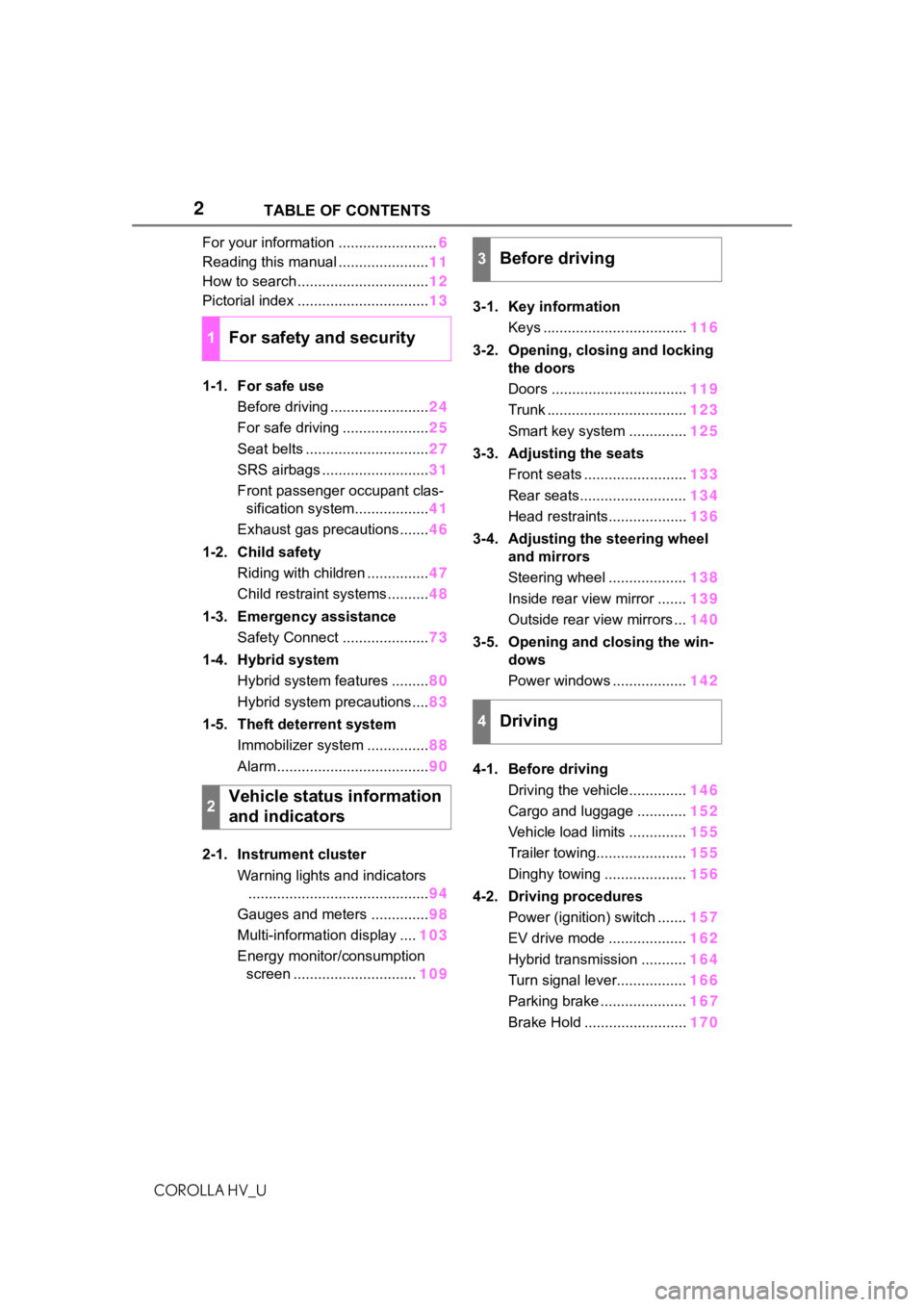
2
COROLLA HV_UTABLE OF CONTENTS
For your information ........................
6
Reading this manual ...................... 11
How to search ................................ 12
Pictorial index ................................ 13
1-1. For safe use Before driving ........................ 24
For safe driving ..................... 25
Seat belts .............................. 27
SRS airbags .......................... 31
Front passenger occupant clas- sification system.................. 41
Exhaust gas precautions....... 46
1-2. Child safety Riding with children ............... 47
Child restraint systems .......... 48
1-3. Emergency assistance Safety Connect ..................... 73
1-4. Hybrid system Hybrid system features ......... 80
Hybrid system precautions .... 83
1-5. Theft deterrent system Immobilizer system ............... 88
Alarm ..................................... 90
2-1. Instrument cluster Warning lights and indicators............................................ 94
Gauges and meters .............. 98
Multi-information display .... 103
Energy monitor/consumption screen .............................. 1093-1. Key information
Keys ................................... 116
3-2. Opening, closing and locking the doors
Doors ................................. 119
Trunk .................................. 123
Smart key system .............. 125
3-3. Adjusting the seats Front seats ......................... 133
Rear seats.......................... 134
Head restraints................... 136
3-4. Adjusting the steering wheel and mirrors
Steering wheel ................... 138
Inside rear view mirror ....... 139
Outside rear view mirrors ... 140
3-5. Opening and closing the win- dows
Power windows .................. 142
4-1. Before driving Driving the vehicle.............. 146
Cargo and luggage ............ 152
Vehicle load limits .............. 155
Trailer towing...................... 155
Dinghy towing .................... 156
4-2. Driving procedures Power (ignition) switch ....... 157
EV drive mode ................... 162
Hybrid transmission ........... 164
Turn signal lever................. 166
Parking brake ..................... 16
7
Brake Hold
......................... 170
1For safety and security
2Vehicle status information
and indicators
3Before driving
4Driving
Page 15 of 584
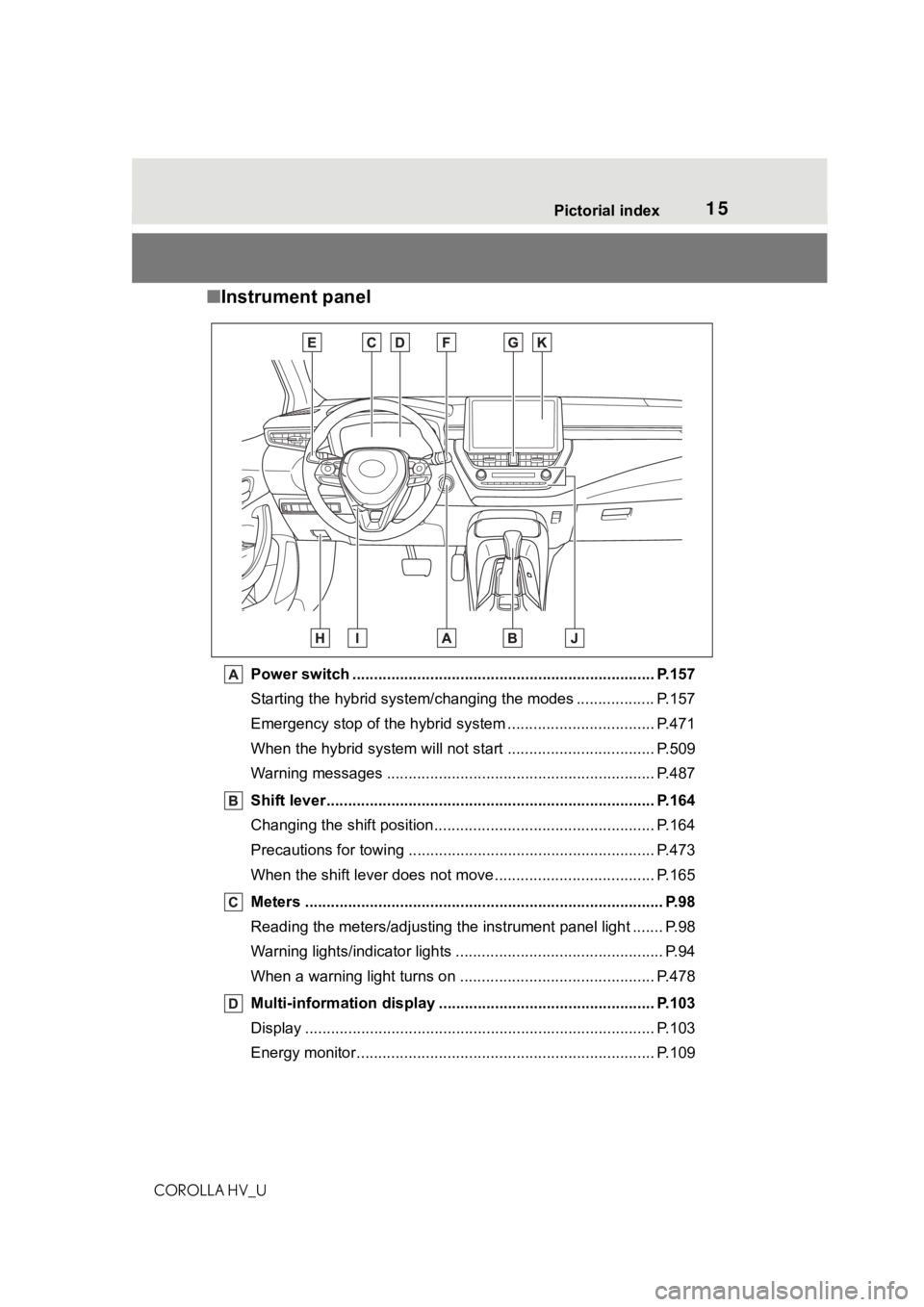
15Pictorial index
COROLLA HV_U
■ Instrument panel
Power switch ................................................... ................... P.157
Starting the hybrid system/changing the modes .................. P. 1 5 7
Emergency stop of the hybrid system ............................ ...... P.471
When the hybrid system will not start .......................... ........ P.509
Warning messages ............................................... ............... P.487
Shift lever.................................................... ........................ P.164
Changing the shift position.................................... ............... P.164
Precautions for towing .. ....................................... ................ P.473
When the shift lever does not move............................. ........ P.165
Meters ......................................................... .......................... P.98
Reading the meters/adjusting the instrument panel light ....... P .98
Warning lights/indicator lights ................................ ................ P.94
When a warning light turns on .................................. ........... P.478
Multi-information display . ................................................. P.103
Display ........................................................ ......................... P.103
Energy monitor................................................. .................... P.109
Page 63 of 584
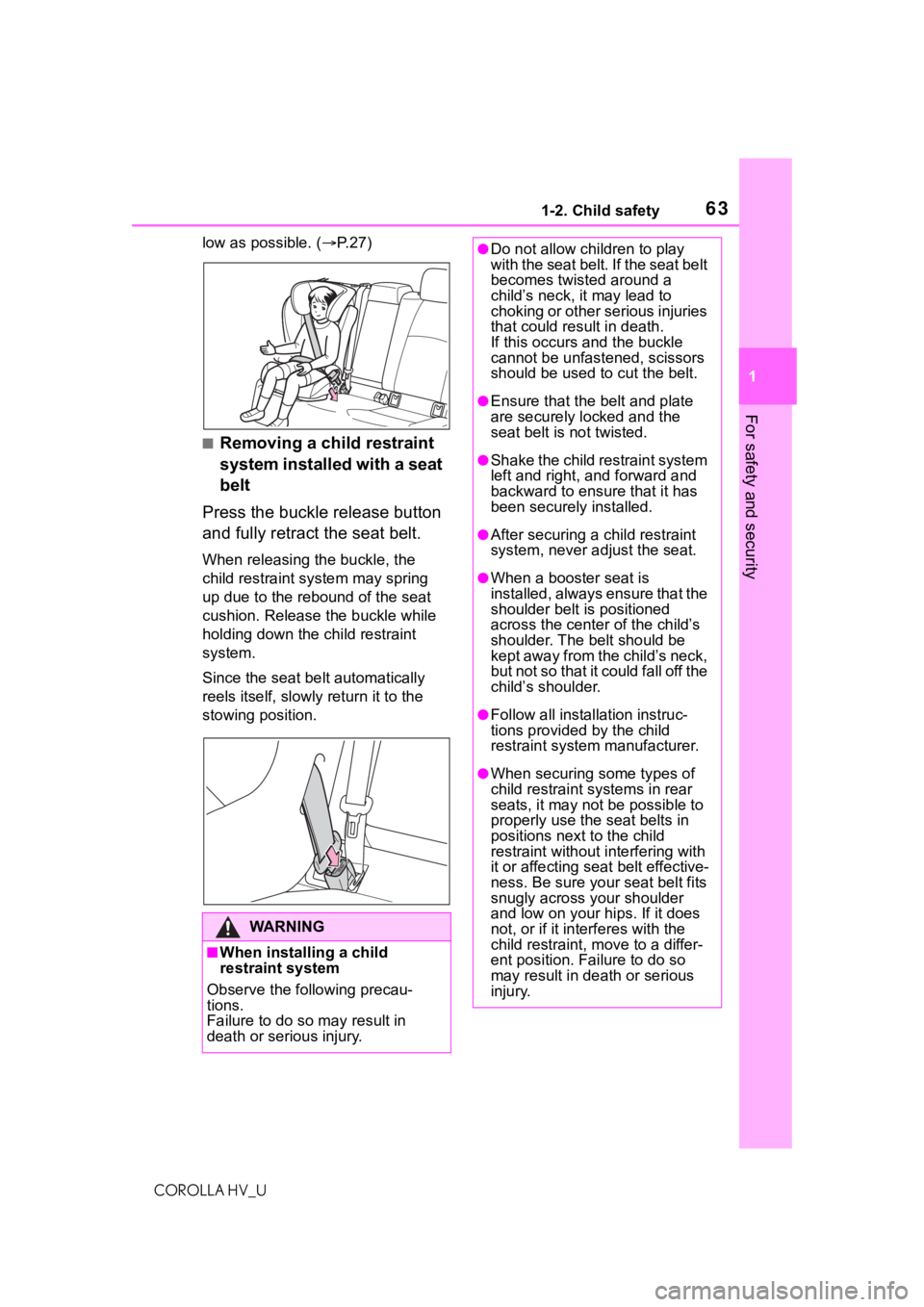
631-2. Child safety
COROLLA HV_U
1
For safety and security
low as possible. ( P.27)
■Removing a child restraint
system installed with a seat
belt
Press the buckle release button
and fully retract the seat belt.
When releasing the buckle, the
child restraint system may spring
up due to the rebound of the seat
cushion. Release the buckle while
holding down the child restraint
system.
Since the seat belt automatically
reels itself, slowly return it to the
stowing position.
WA R N I N G
■When installing a child
restraint system
Observe the following precau-
tions.
Failure to do so m ay result in
death or serious injury.
●Do not allow children to play
with the seat belt. If the seat belt
becomes twisted around a
child’s neck, it may lead to
choking or other serious injuries
that could result in death.
If this occurs and the buckle
cannot be unfastened, scissors
should be used to cut the belt.
●Ensure that the belt and plate
are securely locked and the
seat belt is not twisted.
●Shake the child restraint system
left and right, and forward and
backward to ensure that it has
been securely installed.
●After securing a child restraint
system, never adjust the seat.
●When a booster seat is
installed, always ensure that the
shoulder belt is positioned
across the center of the child’s
shoulder. The belt should be
kept away from the child’s neck,
but not so that it could fall off the
child’s shoulder.
●Follow all installation instruc-
tions provided by the child
restraint system manufacturer.
●When securing some types of
child restraint systems in rear
seats, it may not be possible to
properly use the seat belts in
positions next to the child
restraint without interfering with
it or affecting seat belt effective-
ness. Be sure your seat belt fits
snugly across your shoulder
and low on your hips. If it does
not, or if it interferes with the
child restraint, move to a differ-
ent position. Fa ilure to do so
may result in death or serious
injury.
Page 79 of 584
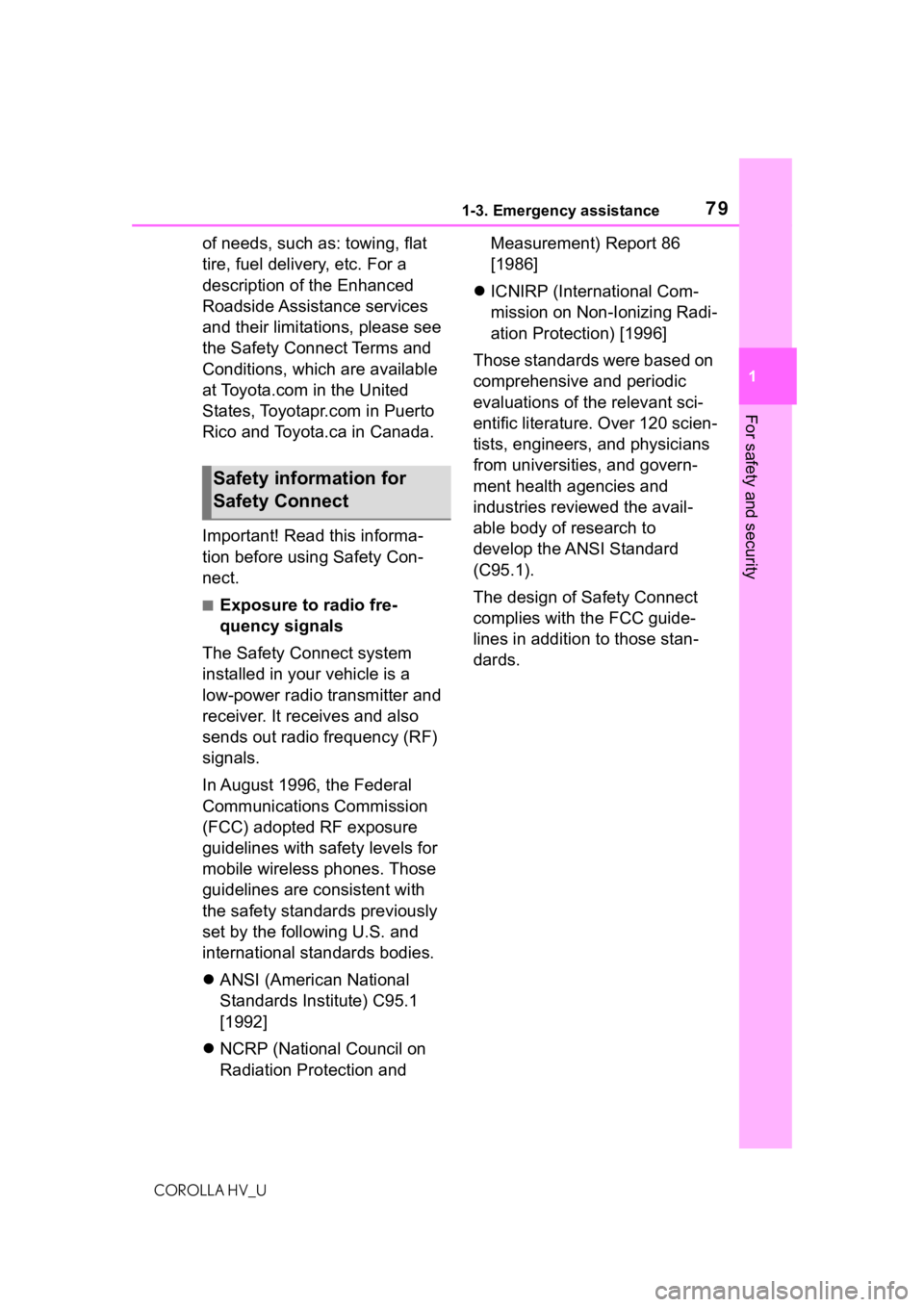
791-3. Emergency assistance
COROLLA HV_U
1
For safety and security
of needs, such as: towing, flat
tire, fuel delivery, etc. For a
description of the Enhanced
Roadside Assistance services
and their limitations, please see
the Safety Connect Terms and
Conditions, which are available
at Toyota.com in the United
States, Toyotapr.com in Puerto
Rico and Toyota.ca in Canada.
Important! Read this informa-
tion before using Safety Con-
nect.
■Exposure to radio fre-
quency signals
The Safety Connect system
installed in your vehicle is a
low-power radio transmitter and
receiver. It receives and also
sends out radio frequency (RF)
signals.
In August 1996, the Federal
Communications Commission
(FCC) adopted RF exposure
guidelines with safety levels for
mobile wireless phones. Those
guidelines are consistent with
the safety standards previously
set by the following U.S. and
international standards bodies.
ANSI (American National
Standards Institute) C95.1
[1992]
NCRP (National Council on
Radiation Protection and Measurement) Report 86
[1986]
ICNIRP (International Com-
mission on Non-Ionizing Radi-
ation Protection) [1996]
Those standards were based on
comprehensive and periodic
evaluations of the relevant sci-
entific literature. Over 120 scien-
tists, engineers, and physicians
from universities, and govern-
ment health agencies and
industries reviewed the avail-
able body of research to
develop the ANSI Standard
(C95.1).
The design of Safety Connect
complies with the FCC guide-
lines in addition to those stan-
dards.
Safety information for
Safety Connect
Page 85 of 584
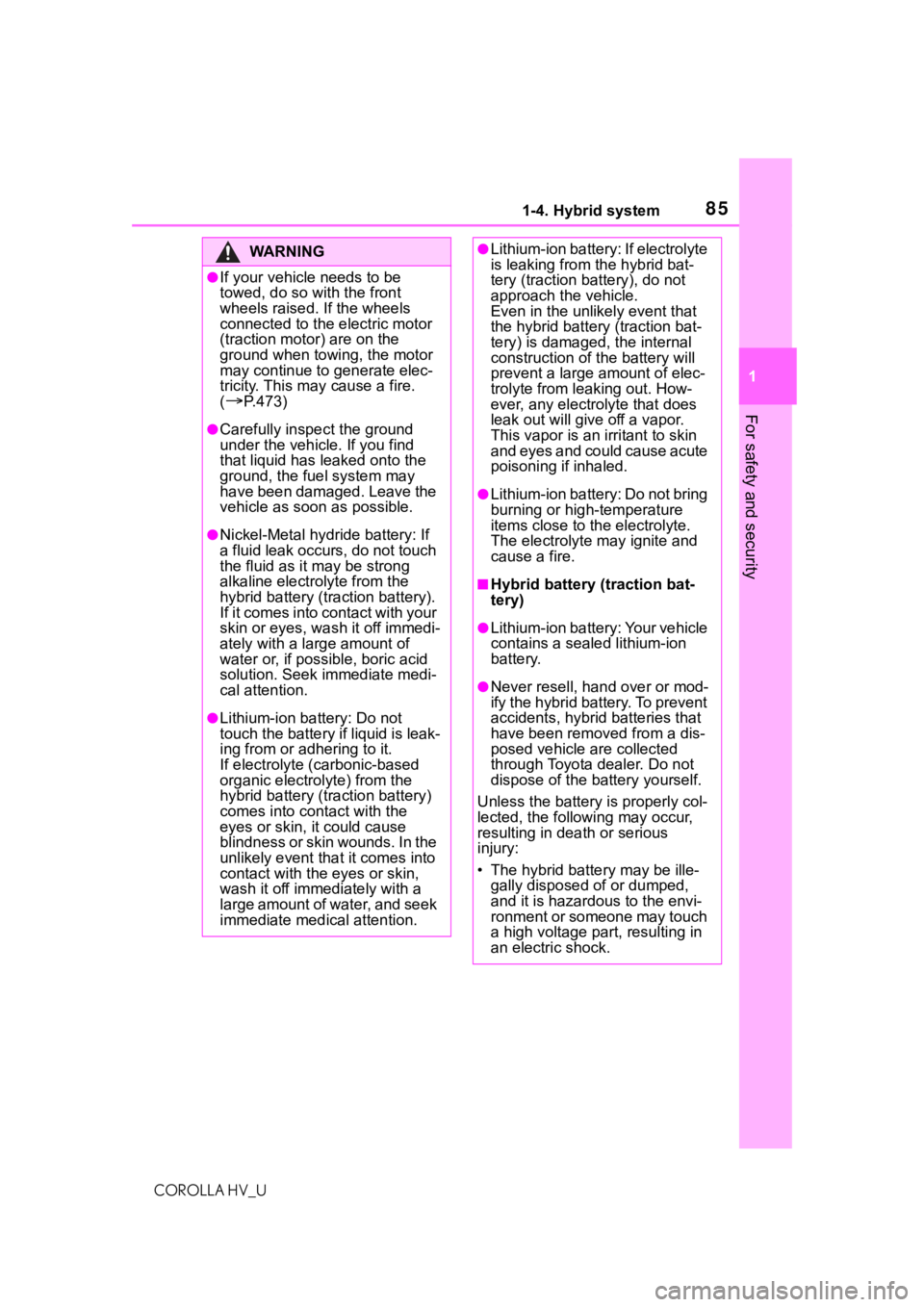
851-4. Hybrid system
COROLLA HV_U
1
For safety and security
WA R N I N G
●If your vehicle needs to be
towed, do so with the front
wheels raised. If the wheels
connected to the electric motor
(traction moto r) are on the
ground when towing, the motor
may continue to generate elec-
tricity. This may cause a fire.
(
P.473)
●Carefully inspect the ground
under the vehicle. If you find
that liquid has leaked onto the
ground, the fuel system may
have been damaged. Leave the
vehicle as soon as possible.
●Nickel-Metal hydr ide battery: If
a fluid leak occurs, do not touch
the fluid as it may be strong
alkaline electrolyte from the
hybrid battery (traction battery).
If it comes into contact with your
skin or eyes, wash it off immedi-
ately with a large amount of
water or, if possible, boric acid
solution. Seek immediate medi-
cal attention.
●Lithium-ion battery: Do not
touch the battery if liquid is leak-
ing from or adhering to it.
If electrolyte (carbonic-based
organic electrolyte) from the
hybrid battery (traction battery)
comes into contact with the
eyes or skin, it could cause
blindness or skin wounds. In the
unlikely event that it comes into
contact with the eyes or skin,
wash it off immediately with a
large amount of water, and seek
immediate medical attention.
●Lithium-ion battery: If electrolyte
is leaking from the hybrid bat-
tery (traction b attery), do not
approach the vehicle.
Even in the unlikely event that
the hybrid battery (traction bat-
tery) is damaged, the internal
construction of the battery will
prevent a large amount of elec-
trolyte from l eaking out. How-
ever, any electrolyte that does
leak out will give off a vapor.
This vapor is an irritant to skin
and eyes and could cause acute
poisoning if inhaled.
●Lithium-ion battery: Do not bring
burning or high-temperature
items close to the electrolyte.
The electrolyte may ignite and
cause a fire.
■Hybrid battery (traction bat-
tery)
●Lithium-ion battery: Your vehicle
contains a sealed lithium-ion
battery.
●Never resell, hand over or mod-
ify the hybrid battery. To prevent
accidents, hybrid batteries that
have been removed from a dis-
posed vehicle are collected
through Toyota dealer. Do not
dispose of the battery yourself.
Unless the battery is properly col-
lected, the following may occur,
resulting in dea th or serious
injury:
• The hybrid batte ry may be ille-
gally disposed of or dumped,
and it is hazardous to the envi-
ronment or someone may touch
a high voltage part, resulting in
an electric shock.
Page 145 of 584
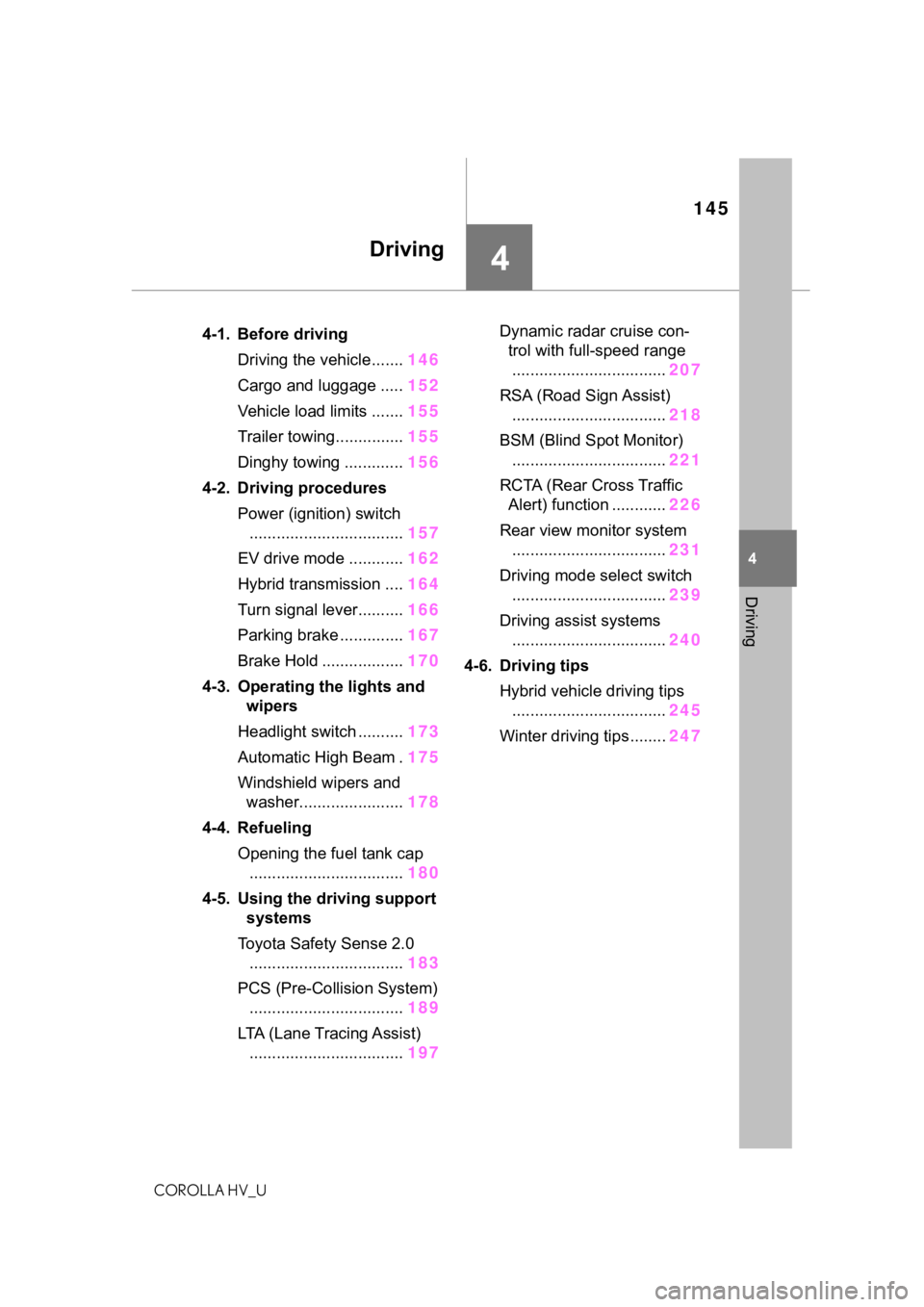
145
COROLLA HV_U
4
4
Driving
Driving
.4-1. Before drivingDriving the vehicle....... 146
Cargo and luggage ..... 152
Vehicle load limits ....... 155
Trailer towing............... 155
Dinghy towing ............. 156
4-2. Driving procedures Power (ignition) switch.................................. 157
EV drive mode ............ 162
Hybrid transmission .... 164
Turn signal lever.......... 166
Parking brake .............. 167
Brake Hold .................. 170
4-3. Operating the lights and wipers
Headlight switch .......... 173
Automatic High Beam . 175
Windshield wipers and washer....................... 178
4-4. Refueling Opening the fuel tank cap.................................. 180
4-5. Using the driving support
systems
Toyota Safety Sense 2.0 .................................. 183
PCS (Pre-Collision System) .................................. 189
LTA (Lane Tracing Assist) .................................. 197Dynamic radar cruise con-
trol with full-speed range.................................. 207
RSA (Road Sign Assist) .................................. 218
BSM (Blind Spot Monitor) .................................. 221
RCTA (Rear Cross Traffic Alert) function ............ 226
Rear view monitor system .................................. 231
Driving mode select switch .................................. 239
Driving assist systems .................................. 240
4-6. Driving tips Hybrid vehicle driving tips.................................. 245
Winter driving tips........ 247
Page 153 of 584
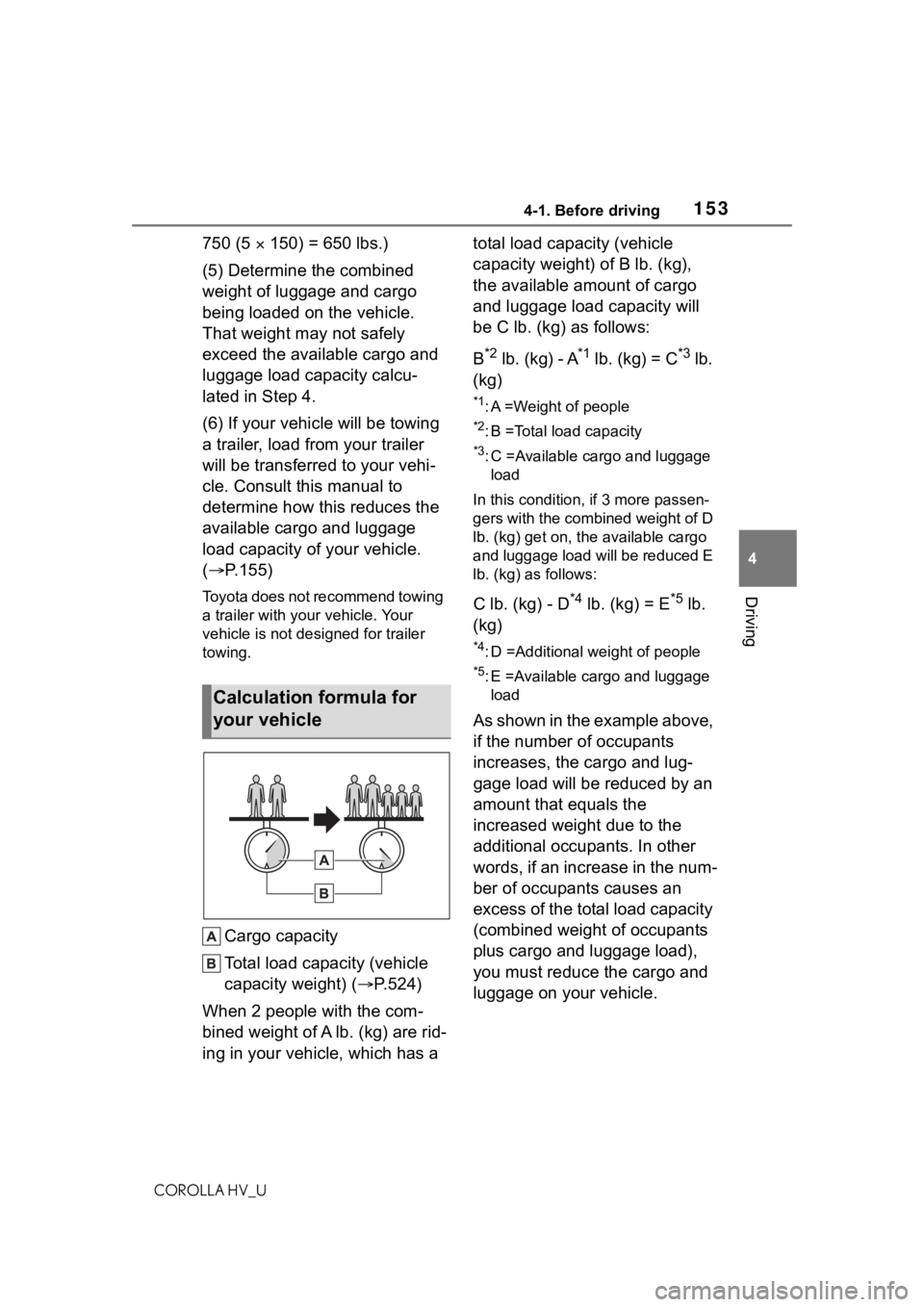
1534-1. Before driving
COROLLA HV_U
4
Driving
750 (5 150) = 650 lbs.)
(5) Determine the combined
weight of luggage and cargo
being loaded on the vehicle.
That weight may not safely
exceed the available cargo and
luggage load capacity calcu-
lated in Step 4.
(6) If your vehicle will be towing
a trailer, load from your trailer
will be transferred to your vehi-
cle. Consult this manual to
determine how this reduces the
available cargo and luggage
load capacity of your vehicle.
( P.155)
Toyota does not recommend towing
a trailer with your vehicle. Your
vehicle is not designed for trailer
towing.
Cargo capacity
Total load capacity (vehicle
capacity weight) ( P.524)
When 2 people with the com-
bined weight of A lb. (kg) are rid-
ing in your vehicle, which has a total load capacity (vehicle
capacity weight) of B lb. (kg),
the available amount of cargo
and luggage load capacity will
be C lb. (kg) as follows:
B
*2 lb. (kg) - A*1 lb. (kg) = C*3 lb.
(kg)
*1: A =Weight of people
*2: B =Total load capacity
*3: C =Available cargo and luggage load
In this condition, if 3 more passen-
gers with the combined weight of D
lb. (kg) get on, the available cargo
and luggage load will be reduced E
lb. (kg) as follows:
C lb. (kg) - D*4 lb. (kg) = E*5 lb.
(kg)
*4: D =Additional weight of people
*5: E =Available cargo and luggage load
As shown in the example above,
if the number of occupants
increases, the cargo and lug-
gage load will be reduced by an
amount that equals the
increased weight due to the
additional occupants. In other
words, if an increase in the num-
ber of occupants causes an
excess of the total load capacity
(combined weight of occupants
plus cargo and luggage load),
you must reduce the cargo and
luggage on your vehicle.
Calculation formula for
your vehicle
Page 155 of 584
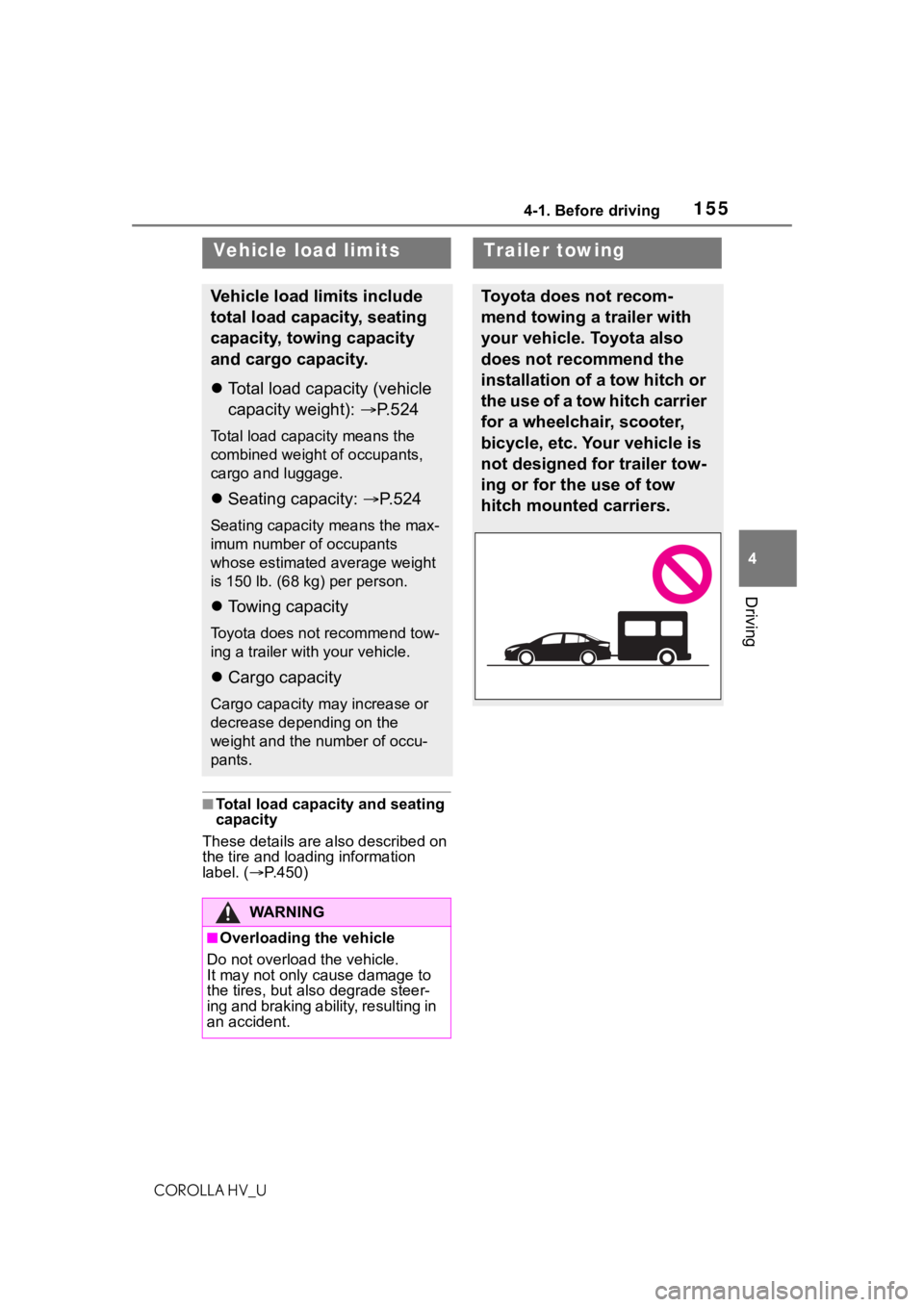
1554-1. Before driving
COROLLA HV_U
4
Driving
■Total load capacity and seating
capacity
These details are also described on
the tire and loading information
label. ( P.450)
Vehicle load limits
Vehicle load limits include
total load capacity, seating
capacity, towing capacity
and cargo capacity.
Total load capacity (vehicle
capacity weight): P. 5 2 4
Total load capacity means the
combined weight of occupants,
cargo and luggage.
Seating capacity: P.524
Seating capacity means the max-
imum number of occupants
whose estimated average weight
is 150 lb. (68 kg) per person.
Towing capacity
Toyota does no t recommend tow-
ing a trailer with your vehicle.
Cargo capacity
Cargo capacity may increase or
decrease depending on the
weight and the number of occu-
pants.
WA R N I N G
■Overloading the vehicle
Do not overload the vehicle.
It may not only cause damage to
the tires, but also degrade steer-
ing and braking ability, resulting in
an accident.
Trailer towing
Toyota does not recom-
mend towing a trailer with
your vehicle. Toyota also
does not recommend the
installation of a tow hitch or
the use of a tow hitch carrier
for a wheelchair, scooter,
bicycle, etc. Your vehicle is
not designed for trailer tow-
ing or for the use of tow
hitch mounted carriers.
Page 156 of 584
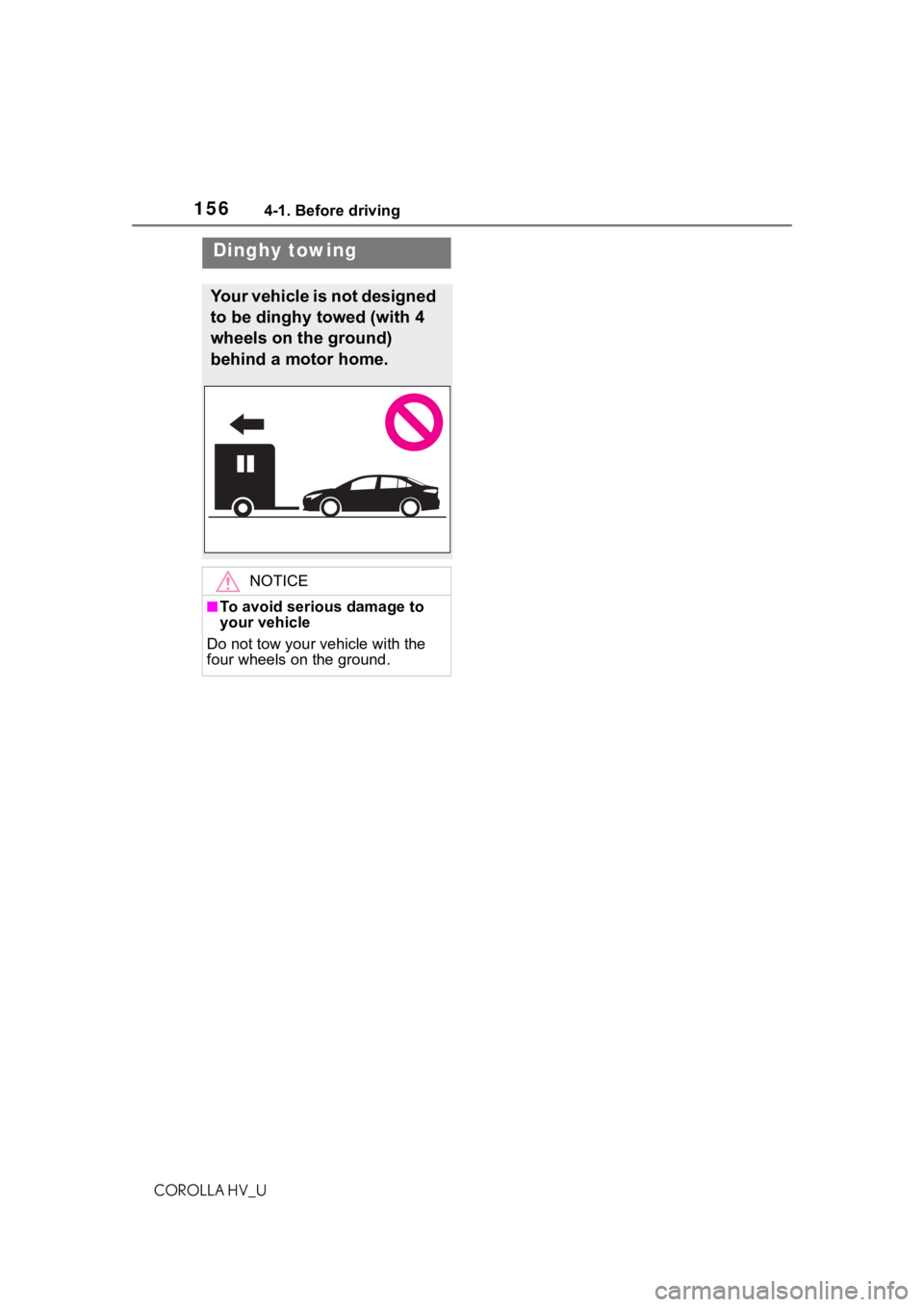
1564-1. Before driving
COROLLA HV_U
Dinghy towing
Your vehicle is not designed
to be dinghy towed (with 4
wheels on the ground)
behind a motor home.
NOTICE
■To avoid serious damage to
your vehicle
Do not tow your vehicle with the
four wheels on the ground.
Page 191 of 584
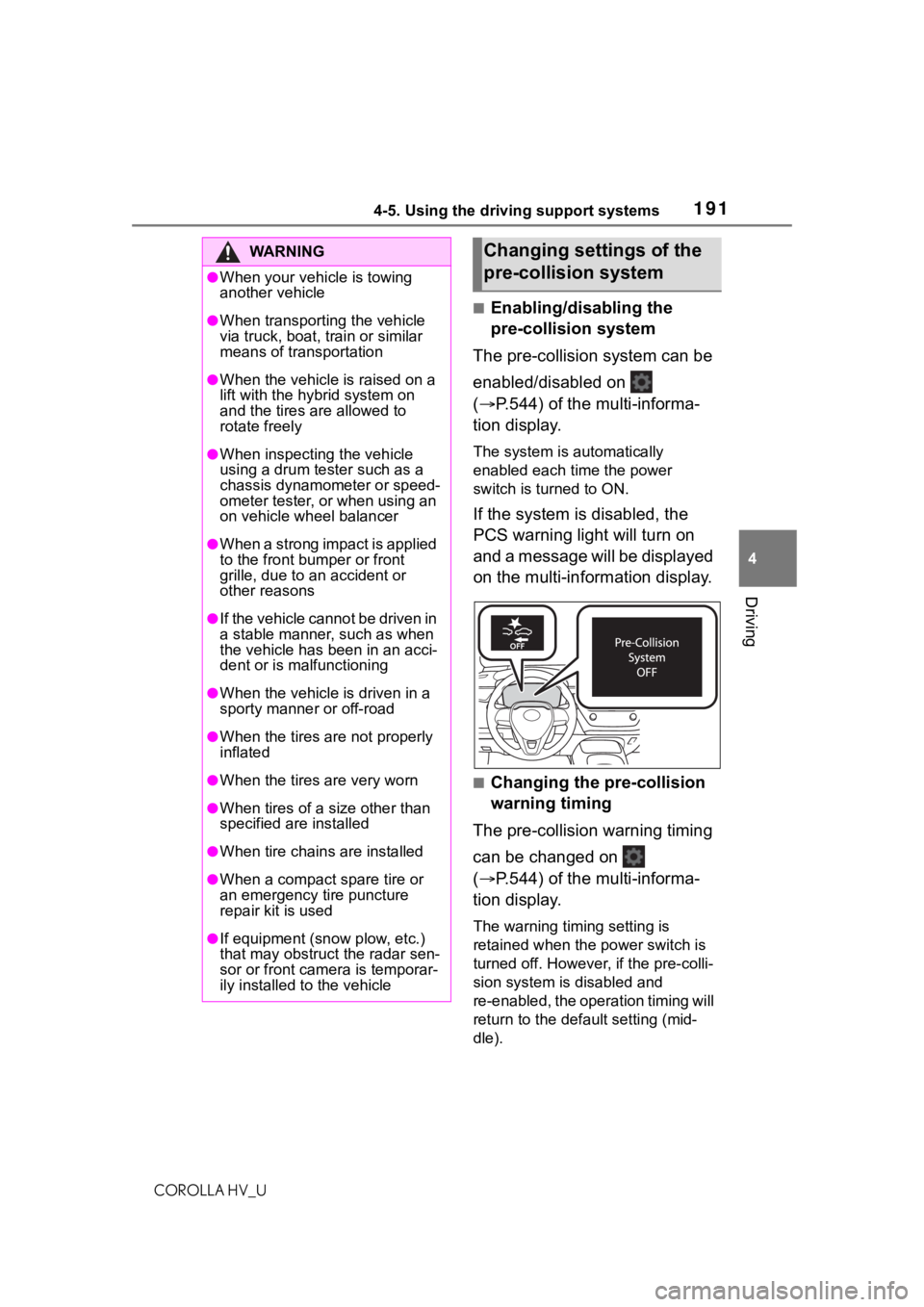
1914-5. Using the driving support systems
COROLLA HV_U
4
Driving
■Enabling/disabling the
pre-collision system
The pre-collision system can be
enabled/disabled on
( P.544) of the multi-informa-
tion display.
The system is automatically
enabled each time the power
switch is turned to ON.
If the system is disabled, the
PCS warning light will turn on
and a message will be displayed
on the multi-information display.
■Changing the pre-collision
warning timing
The pre-collision warning timing
can be changed on
( P.544) of the multi-informa-
tion display.
The warning timing setting is
retained when the power switch is
turned off. Howeve r, if the pre-colli-
sion system is disabled and
re-enabled, the ope ration timing will
return to the default setting (mid-
dle).
WA R N I N G
●When your vehicle is towing
another vehicle
●When transporting the vehicle
via truck, boat, train or similar
means of transportation
●When the vehicle is raised on a
lift with the hybrid system on
and the tires are allowed to
rotate freely
●When inspecting the vehicle
using a drum tester such as a
chassis dynamometer or speed-
ometer tester, or when using an
on vehicle wheel balancer
●When a strong impact is applied
to the front bumper or front
grille, due to a n accident or
other reasons
●If the vehicle cannot be driven in
a stable manner, such as when
the vehicle has been in an acci-
dent or is malfunctioning
●When the vehicle is driven in a
sporty manner or off-road
●When the tires are not properly
inflated
●When the tires are very worn
●When tires of a size other than
specified are installed
●When tire chains are installed
●When a compact spare tire or
an emergency tire puncture
repair kit is used
●If equipment (snow plow, etc.)
that may obstruct the radar sen-
sor or front camera is temporar-
ily installed to the vehicle
Changing settings of the
pre-collision system